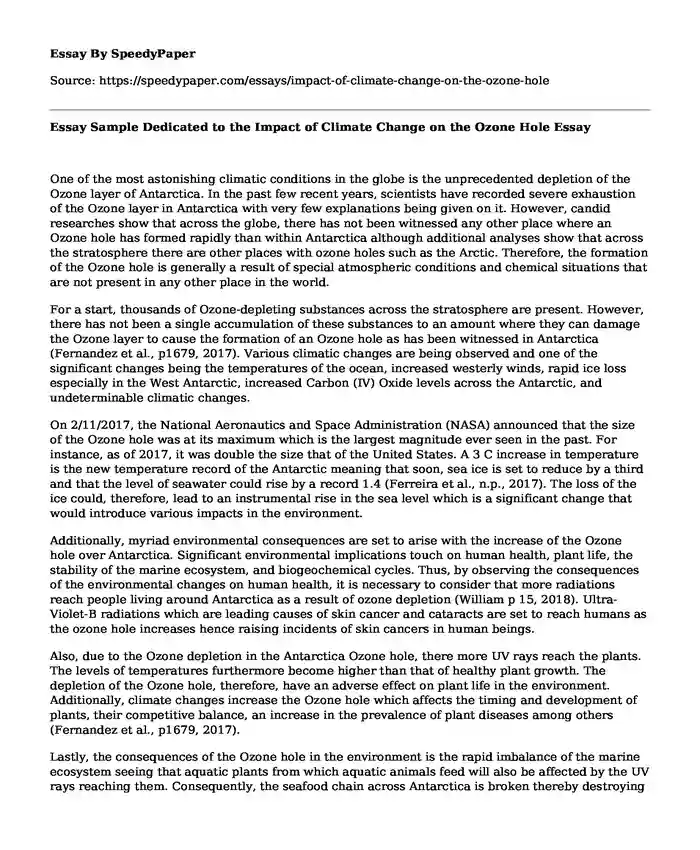
| Type of paper: | Research paper |
| Categories: | Climate change |
| Pages: | 3 |
| Wordcount: | 716 words |
One of the most astonishing climatic conditions in the globe is the unprecedented depletion of the Ozone layer of Antarctica. In the past few recent years, scientists have recorded severe exhaustion of the Ozone layer in Antarctica with very few explanations being given on it. However, candid researches show that across the globe, there has not been witnessed any other place where an Ozone hole has formed rapidly than within Antarctica although additional analyses show that across the stratosphere there are other places with ozone holes such as the Arctic. Therefore, the formation of the Ozone hole is generally a result of special atmospheric conditions and chemical situations that are not present in any other place in the world.
For a start, thousands of Ozone-depleting substances across the stratosphere are present. However, there has not been a single accumulation of these substances to an amount where they can damage the Ozone layer to cause the formation of an Ozone hole as has been witnessed in Antarctica (Fernandez et al., p1679, 2017). Various climatic changes are being observed and one of the significant changes being the temperatures of the ocean, increased westerly winds, rapid ice loss especially in the West Antarctic, increased Carbon (IV) Oxide levels across the Antarctic, and undeterminable climatic changes.
On 2/11/2017, the National Aeronautics and Space Administration (NASA) announced that the size of the Ozone hole was at its maximum which is the largest magnitude ever seen in the past. For instance, as of 2017, it was double the size that of the United States. A 3 C increase in temperature is the new temperature record of the Antarctic meaning that soon, sea ice is set to reduce by a third and that the level of seawater could rise by a record 1.4 (Ferreira et al., n.p., 2017). The loss of the ice could, therefore, lead to an instrumental rise in the sea level which is a significant change that would introduce various impacts in the environment.
Additionally, myriad environmental consequences are set to arise with the increase of the Ozone hole over Antarctica. Significant environmental implications touch on human health, plant life, the stability of the marine ecosystem, and biogeochemical cycles. Thus, by observing the consequences of the environmental changes on human health, it is necessary to consider that more radiations reach people living around Antarctica as a result of ozone depletion (William p 15, 2018). Ultra-Violet-B radiations which are leading causes of skin cancer and cataracts are set to reach humans as the ozone hole increases hence raising incidents of skin cancers in human beings.
Also, due to the Ozone depletion in the Antarctica Ozone hole, there more UV rays reach the plants. The levels of temperatures furthermore become higher than that of healthy plant growth. The depletion of the Ozone hole, therefore, have an adverse effect on plant life in the environment. Additionally, climate changes increase the Ozone hole which affects the timing and development of plants, their competitive balance, an increase in the prevalence of plant diseases among others (Fernandez et al., p1679, 2017).
Lastly, the consequences of the Ozone hole in the environment is the rapid imbalance of the marine ecosystem seeing that aquatic plants from which aquatic animals feed will also be affected by the UV rays reaching them. Consequently, the seafood chain across Antarctica is broken thereby destroying the whole marine ecosystem across Antarctica (Chalapathi et al., p9, 2018). The levels of gases released to the environment also increase and their resulting imbalance is usually experienced. Therefore, the atmospheric buildup of gases such as Carbon (IV) Oxide and Carbon Sulphide destroy the Ozone leading to more severe conditions over Antarctica.
References
Chalapathi, G.V., Eswaraiah, S., Prasanth, P.V., Lee, J., Kumar, K.N. and Kim, Y.H., 2018. Unusual Changes in Stratospheric Ozone and Water Vapor Over Antarctica and its Relation to Mesosphere
Fernandez, R.P., Kinnison, D.E., Lamarque, J.F., Tilmes, S., and Saiz-Lopez, A., 2017. Impact of biogenic very short-lived bromine on the Antarctic ozone hole during the 21st century. Atmospheric Chemistry and Physics, 17(3), pp.1673-1688.
Ferreira, D., Gnanadesikan, A., Kostov, Y., Marshall, J., Seviour, W. and Waugh, D., 2017, December. Response of Antarctic sea surface temperature and sea ice to ozone depletion. In AGU Fall Meeting Abstracts.
Williams, J., 2018. The Ozone Hole: A Story of Healing and Hope. Weatherwise, 71(1), pp.12-17.
Cite this page
Essay Sample Dedicated to the Impact of Climate Change on the Ozone Hole. (2022, Aug 30). Retrieved from https://speedypaper.com/essays/impact-of-climate-change-on-the-ozone-hole
Request Removal
If you are the original author of this essay and no longer wish to have it published on the SpeedyPaper website, please click below to request its removal:
- Essay Sample on the Progressive Era in the United States of America
- Free Essay Example about the Lean Principle in Production
- Free Essay with a Reflection on Some Movies
- Free Essay on Healthcare Cost and Epidemiology Development
- Essay Sample: Teamwork, Collaboration, And Communication Strategies
- Essay Example on Mark Twain's Contributions to World Literature
- Persuade my audience that Colorado police officers should not wear body cameras
Popular categories




